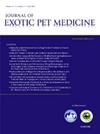USE OF PROPOFOL ASSOCIATED WITH METHADONE AND LOCAL BLOCKADE WITH LIDOCAINE IN SIX SPECIMENS OF FRESHWATER STINGRAYS (Potamotrygon spp.)
IF 0.6
4区 农林科学
Q4 VETERINARY SCIENCES
引用次数: 0
Abstract
Fish are the most diverse group of vertebrates, and their main characteristic is their aquatic habitat, with primary respiration through gills and ectothermy. The Potamotrygonidae is a family of cartilaginous fish that includes freshwater rays from South America. As they are restricted to freshwater environments, they possess anatomic and physiological particularities that differentiate them from other elasmobranchs. Potamotrygon is the most diverse genus, and although they are not aggressive fish, stingrays of this genus have a retro-serrated barb covered by a venom-producing glandular epithelium. This work aims to report the anesthetic protocol for barb resection from stingrays of two species from the genus Potamotrygon. Six stingrays (Potamotrygon falkneri, n = 3; P. leopoldi, n = 3) were sent to the Veterinary Hospital of the Federal University of Uberlândia (HVET-UFU) for surgical removal of the barb. The anesthetic protocol consisted of premedication with methadone administered intramuscularly, induction with propofol in the spiracles and local blockade with lidocaine without vasoconstriction. Trans-anesthetic monitoring was performed regarding the animals' water temperature, respiratory rate, and heart rate. All animals had fully recovered from anesthesia within five minutes, and no complications were recorded. Although the anesthesiology of elasmobranch fishes is still uncertain due to the scarcity of experimental models, the launched protocol yielded satisfactory results for promoting relaxation, analgesia, and rapid recovery.
异丙酚联合美沙酮和利多卡因局部阻断在6种淡水黄貂鱼标本中的应用
鱼类是最多样化的脊椎动物群体,它们的主要特征是它们的水生栖息地,通过鳃进行初级呼吸和变温。软骨鱼科是一科软骨鱼,包括来自南美洲的淡水鳐鱼。由于它们只生活在淡水环境中,因此它们具有解剖学和生理学上的特殊性,使它们与其他板鳃目动物区别开来。黄貂鱼是最多样化的属,虽然它们不是侵略性的鱼,但这种属的黄貂鱼有一个向后锯齿状的倒刺,上面覆盖着分泌毒液的腺上皮。本工作旨在报道两种黄貂鱼鱼刺切除的麻醉方案。六黄貂鱼(Potamotrygon falkneri, n = 3;P. leopoldi, n = 3)被送往印度联邦大学兽医医院(HVET-UFU)进行手术切除倒刺。麻醉方案包括肌内美沙酮预用药,异丙酚诱导气门,利多卡因局部阻断,无血管收缩。经麻醉监测动物的水温、呼吸频率和心率。所有动物在5分钟内完全从麻醉中恢复,无并发症记录。尽管由于缺乏实验模型,板鳃鱼的麻醉机理仍不确定,但启动的方案在促进松弛、镇痛和快速恢复方面取得了令人满意的结果。
本文章由计算机程序翻译,如有差异,请以英文原文为准。
求助全文
约1分钟内获得全文
求助全文
来源期刊

Journal of Exotic Pet Medicine
农林科学-兽医学
CiteScore
1.20
自引率
0.00%
发文量
65
审稿时长
60 days
期刊介绍:
The Journal of Exotic Pet Medicine provides clinicians with a convenient, comprehensive, "must have" resource to enhance and elevate their expertise with exotic pet medicine. Each issue contains wide ranging peer-reviewed articles that cover many of the current and novel topics important to clinicians caring for exotic pets. Diagnostic challenges, consensus articles and selected review articles are also included to help keep veterinarians up to date on issues affecting their practice. In addition, the Journal of Exotic Pet Medicine serves as the official publication of both the Association of Exotic Mammal Veterinarians (AEMV) and the European Association of Avian Veterinarians (EAAV). The Journal of Exotic Pet Medicine is the most complete resource for practitioners who treat exotic pets.
 求助内容:
求助内容: 应助结果提醒方式:
应助结果提醒方式:


